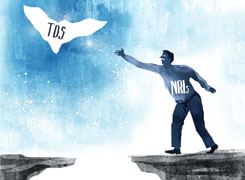Indian Expat with Foreign Currency Deposits: What Are My Options?
Ramalingam Kalirajan |10881 Answers |Ask -Follow
Mutual Funds, Financial Planning Expert - Answered on Jan 20, 2025
He has an MBA in finance from the University of Madras and is a certified financial planner.
He is the director and chief financial planner at Holistic Investment, a Chennai-based firm that offers financial planning and wealth management advice.... more

I m a person of Indian origin with citizenship of other country. I have bank accounts in India, both in INR and USD €. One of my Term deposit is with SBI while all others are BoB. I m thinking of options. 1. Encash it 2. Move to Bank of Baroda 3. Repatriate. As I m retiring option 3 is not favorable. If I encash it I m told I get INR equivalent to deposit. Moving to BoB appears to be best option but again according to SBI it will involve changing to INR and but USD snd then go to HQ of BoB to put it in Term Deposit. I also had cash USD 5,000 and wanted to deposit in Term Deposit but SBI says only District office can do that while in past they accepted it their branch. Another confusion is remittance of USD to be in Term deposit here but every time I try i get INR..... Plz if you have any guidance within thr laws guide me. Reason I want all in BoB is I am retired and want every thing within comfortable distance Thank yoy
Key Observations
You have INR and USD accounts in India, with term deposits spread across SBI and BoB.
You prefer keeping all deposits with BoB for ease of management post-retirement.
You face challenges in transferring USD and opening term deposits with USD funds.
You want a legally compliant and cost-effective solution that aligns with your retirement needs.
Option 1: Encash the Term Deposits
Process:
Encashing your SBI term deposit will provide INR equivalent to the deposit amount.
The proceeds can be deposited into your BoB account for reinvestment.
Advantages:
This is a straightforward process for INR deposits.
Funds can be reinvested into term deposits at BoB without additional conversion.
Disadvantages:
For USD term deposits, SBI may convert the amount into INR before crediting your account.
You may lose out on favourable USD interest rates or incur currency conversion charges.
Option 2: Move Term Deposits to BoB
Process:
Transfer INR term deposits directly to BoB upon maturity for reinvestment.
For USD deposits, SBI may convert them to INR before transferring to BoB.
BoB requires approval from their head office for accepting USD deposits, which could delay the process.
Advantages:
Consolidating all deposits into BoB ensures easier access and management.
BoB offers competitive interest rates on both INR and USD deposits.
Disadvantages:
Transferring USD term deposits requires conversion into INR and reconversion into USD at BoB.
Double currency conversion can result in exchange rate losses and fees.
Option 3: Repatriate the Funds
Process:
Transfer the USD term deposit amount to your overseas bank account.
Use these funds for investments or term deposits in your country of citizenship.
Advantages:
Repatriation is a compliant option under FEMA (Foreign Exchange Management Act).
Funds in your country of citizenship may be easier to access and manage.
Disadvantages:
You find this option unfavourable due to retirement and a preference for Indian banking.
Exchange rates and transfer fees may erode part of the value.
Additional Guidance for USD Cash Deposits
SBI's Policy on USD Deposits: As per current rules, only district or designated branches may handle USD cash deposits for term deposits. This rule ensures compliance with foreign exchange regulations.
Options to Consider:
Visit the designated SBI district branch to deposit USD cash into a term deposit.
Alternatively, convert the USD to INR and invest in a term deposit with INR.
Why Policies Changed: RBI regulations often impact how banks handle foreign currency transactions. These rules are in place to prevent unauthorised foreign exchange dealings.
Recommended Approach
Consolidate Deposits in BoB
This aligns with your preference for convenience and a single point of access.
Upon maturity, instruct SBI to transfer INR deposits directly to BoB.
For USD deposits, consult BoB to understand their procedures and avoid unnecessary conversions.
Minimise Currency Conversions
Currency conversion between INR and USD results in fees and exchange rate losses.
Avoid unnecessary conversions by keeping USD deposits in their original currency, if possible.
Check BoB's Foreign Currency Deposit Policies
Confirm with BoB whether your local branch can handle USD term deposits.
If not, clarify the procedure for head office approval and processing.
Use USD Remittances Wisely
If remittance results in INR instead of USD, it may be due to your bank's default settings.
Specify that the remittance should be credited to your USD account. This ensures funds remain in the desired currency.
Monitor Compliance with FEMA
Ensure all transactions comply with FEMA guidelines.
Seek assistance from your bank’s NRI desk for better clarity on compliance and documentation.
Final Insights
Your plan to consolidate all deposits in Bank of Baroda is a smart step for retirement management. Avoid unnecessary currency conversions and ensure compliance with RBI and FEMA rules. Consult the BoB branch manager and their NRI desk for personalised support to streamline the process.
Best Regards,
K. Ramalingam, MBA, CFP,
Chief Financial Planner,
www.holisticinvestment.in
https://www.youtube.com/@HolisticInvestment
You may like to see similar questions and answers below
Ramalingam Kalirajan |10881 Answers |Ask -Follow
Mutual Funds, Financial Planning Expert - Answered on Apr 27, 2024
Vivek Lala |323 Answers |Ask -Follow
Tax, MF Expert - Answered on Jul 09, 2024
T S Khurana |536 Answers |Ask -Follow
Tax Expert - Answered on Mar 05, 2025
Naveenn Kummar |235 Answers |Ask -Follow
Financial Planner, MF, Insurance Expert - Answered on Sep 11, 2025
Kanchan Rai |646 Answers |Ask -Follow
Relationships Expert, Mind Coach - Answered on Dec 12, 2025
Ravi Mittal |677 Answers |Ask -Follow
Dating, Relationships Expert - Answered on Dec 12, 2025
Ramalingam Kalirajan |10881 Answers |Ask -Follow
Mutual Funds, Financial Planning Expert - Answered on Dec 12, 2025
Ramalingam Kalirajan |10881 Answers |Ask -Follow
Mutual Funds, Financial Planning Expert - Answered on Dec 12, 2025
Reetika Sharma |423 Answers |Ask -Follow
Financial Planner, MF and Insurance Expert - Answered on Dec 12, 2025
Reetika Sharma |423 Answers |Ask -Follow
Financial Planner, MF and Insurance Expert - Answered on Dec 12, 2025
Reetika Sharma |423 Answers |Ask -Follow
Financial Planner, MF and Insurance Expert - Answered on Dec 12, 2025
Reetika Sharma |423 Answers |Ask -Follow
Financial Planner, MF and Insurance Expert - Answered on Dec 12, 2025
Reetika Sharma |423 Answers |Ask -Follow
Financial Planner, MF and Insurance Expert - Answered on Dec 12, 2025
Mayank Chandel |2572 Answers |Ask -Follow
IIT-JEE, NEET-UG, SAT, CLAT, CA, CS Exam Expert - Answered on Dec 11, 2025




























